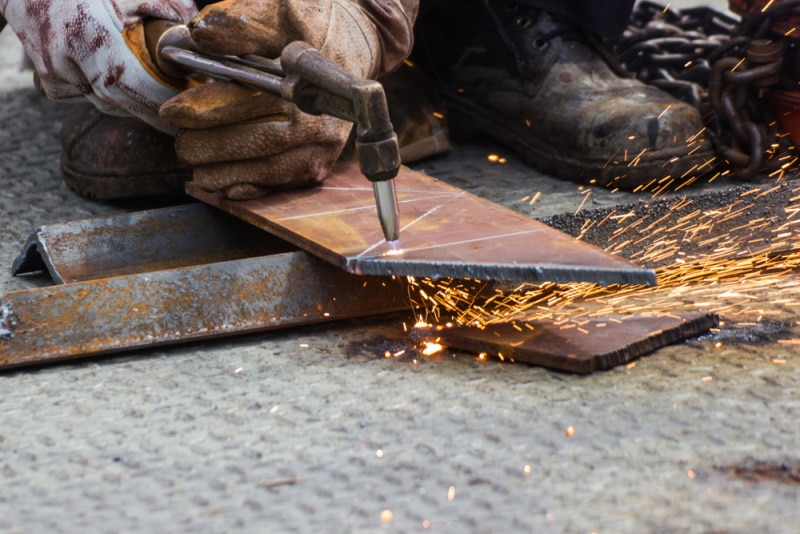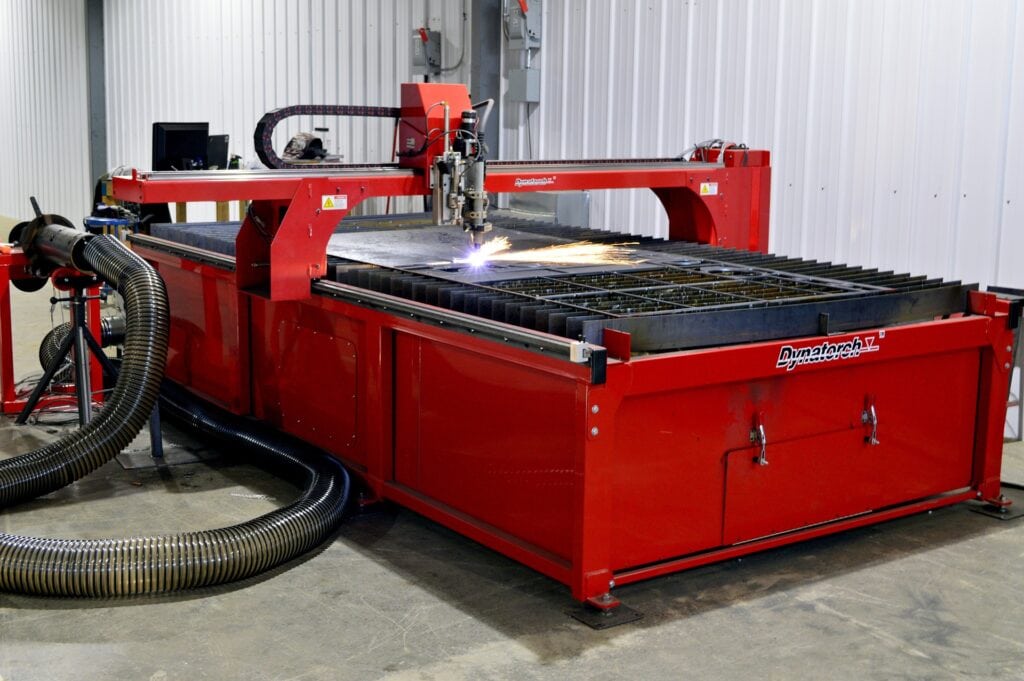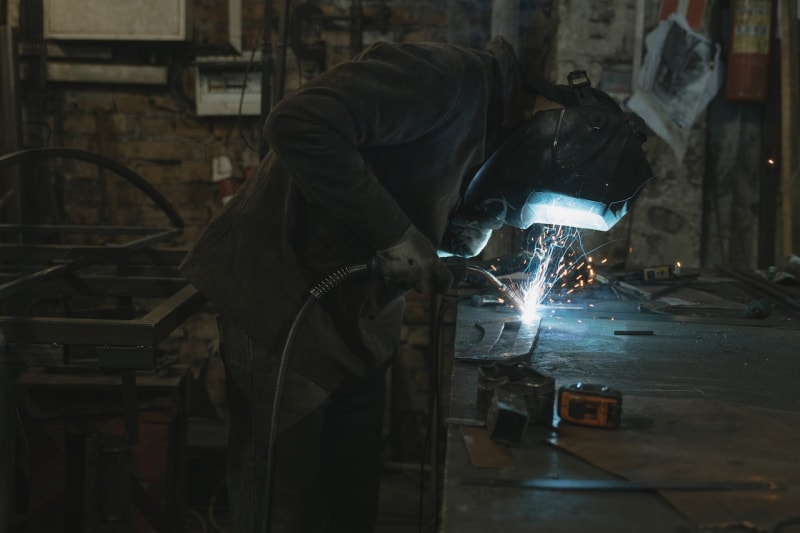How Does a Plasma Cutter Work? What You Need To Know
-

- Last updated:

Plasma cutters are innovative tools that use an electrical arc to melt and cut metal. They’ve revolutionized the metalworking industry, allowing faster and more precise cuts. To understand how plasma cutters work is to better appreciate the technology behind them.
In this guide, we dive deep into the science behind plasma cutting and explain how you can use this highly effective tool to shape metal.
How Does It Work?
Plasma cutters use an electrical arc to melt metal. This is done by passing a stream of electrically charged gas through a narrow nozzle at the end of the torch. The gas is heated up to such levels that it becomes ionized and forms plasma, which has enough energy to cut through virtually any metal.
The plasma cutter delivers a high-velocity stream of ionized gas from the nozzle onto the metal surface. This creates an electrical arc, which melts anything in its path and forms a molten pool. Pressure is then applied to this pool, forcing it along a predetermined path to create a clean cut.
In CNC plasma cutters, a CNC (computer numerical control—more on this below) machine controls the cutting process, allowing for greater precision and accuracy. Many industries rely on CNC plasma cutters to produce intricate and complex shapes and do so on a mass scale daily.
CNC plasma cutters have enabled a wide range of manufacturers to create parts for many different applications. From automotive to aerospace, CNC plasma cutters are finding their way into more and more manufacturing processes.
What Are the Different Types of Plasma Cutters?

Plasma cutters come in various shapes and sizes, ranging from portable handheld units to large industrial machines. The type of plasma cutter you need will depend on your project requirements. Let’s examine some of the most common types of plasma cutters:
Air Plasma
Air plasma cutters are the most basic type of plasma cutter. They use compressed air to create an electrical arc and can be used for small cutting jobs. As such, they’re widely used in DIY and hobbyist settings.
Oxygen Plasma
Oxygen plasma cutters are more powerful than air plasma cutters and are better suited for larger projects. They use oxygen gas as the cutting medium, which creates a more powerful arc and allows for faster, more accurate cuts.
High-Definition Plasma
High-definition plasma cutters are advanced cutting machines that use advanced technology to create an even more precise arc and ultra-high-quality cuts. They are typically used for intricate projects where precision is key.
CNC Plasma
Computer numerical control plasma cutters are automated machines that use specialized software and advanced mechanics to create highly precise cuts. They can be programmed to carry out complex cutting jobs and are often used in industrial applications.
Regardless of which type of plasma cutter you choose, they all operate on the same principle: using an electrical arc to melt and shape metal.
Where Is It Used?

Plasma cutters are used in a variety of industries and applications. They are used to create everything from automotive components to sculpture, jewelry, and more. You can use plasma cutters on various materials, including aluminum, steel, stainless steel, copper, and other metals.
These revolutionary tools are predominantly seen in industrial settings but have become increasingly popular in the home workshop, as well. In fact, the portability and affordability of modern plasma cutters make them an ideal tool for the DIY enthusiast.
Advantages of Plasma Cutters
Plasma cutters offer many benefits over traditional cutting methods. Here are some of the advantages they offer:
Speed: Plasma cutters can cut through metal at lightning-fast speeds of up to 300 inches per minute. This makes them much faster than other cutting methods, such as oxy-fuel cutting.
Precision: Plasma cutters create highly precise cuts, allowing for complex shapes and intricate details to be achieved with ease.
Cost Efficiency: Plasma cutters are much more cost-efficient than other cutting methods. They require fewer consumables and less setup time, making them an economical choice for many projects.
Disadvantages of Plasma Cutters
Despite the advantages they offer, plasma cutters also have some drawbacks.
High Initial Cost: The initial cost of a plasma cutter can be quite high, especially for industrial-grade models.
Power Requirements: Plasma cutters require a lot of power, so they must be used with a generator or sufficient power source.
As you can see, the downsides to plasma cutters are few. With proper training and maintenance, they can be a reliable and cost-effective tool for many cutting jobs.
Frequently Asked Questions (FAQs)

How hot does a plasma cutter get?
A plasma cutter can reach temperatures of more than 45,000°F. Hotter than the sun, plasma cutters can cut through any type of metal, including aluminum and steel. But because of this extreme heat output, proper safety precautions are an absolute necessity.
What types of gasses are used in a plasma cutting machine?
Depending on the model, most plasma cutters use argon, nitrogen, or air as a cutting gas. Argon is typically preferred for thicker metals, while nitrogen is often used for stainless steel, aluminum, and other thin materials.
How much power does a plasma cutter need?
Generally speaking, most machines require around 1,000 amps—or more. Power requirements vary depending on the type and size of the project as well as the thickness of the material that needs to be cut.
Before investing in or using a plasma cutter, make sure you understand the power requirements and safety precautions needed for proper use.
Many hobbyists find that they need to rewire their shops for higher amperage in order to accommodate the high-powered machine. It’s also essential to check your circuit breaker to ensure it can handle the power draw of the plasma cutter.
How thick can a plasma cutter cut?
Plasma cutters can cut through materials of varying thicknesses—from around 1/16 inch up to 2 inches or more. The size and type of material will determine how thick the plasma cutter can cut. In general, though, most plasma cutters can manage a thickness of 1 inch.
What is the duty cycle of a plasma cutter?
The duty cycle of a plasma cutter refers to how long it can continuously run before needing to cool down. Most models have a duty cycle of 10 minutes or less. This means that after 10 minutes of continuous use, the machine needs to rest for 10 minutes before it can be used again.
Are there any safety concerns with using a plasma cutter?
Yes, you should always wear protective gear when working with a plasma cutter, as it produces intense heat and light that can cause serious injury. Moreover, the use of compressed gasses and electrical shock poses potential risks.
Always follow the manufacturer’s instructions for proper safety and operation. Always make sure that your workspace is well-ventilated and free from flammable materials.
Do plasma cutters require a lot of maintenance?
Yes, many users find that regular maintenance is necessary for optimal performance. Depending on the type of machine and usage, regular maintenance can include cleaning the nozzles, replacing consumable parts, and checking for electrical or mechanical issues. Doing so will help ensure your plasma cutter is running efficiently and safely.
A Quick Reference Guide
Use the table below to see when it’s suitable to use one type of plasma cutter over another based on the task at hand.
| Air Plasma | High-Definition Plasma | CNC Plasma | Oxygen Plasma |
| Thin aluminum | Stainless steel | High detail projects | Thick steel |
| DIY projects | Thicker aluminum | Intricate shapes | Cast iron |
| Light-duty welding | Heavy-duty welding | Small radius cuts | Heavy-duty welding |
Conclusion
A plasma cutter is an incredibly versatile tool that can be used to cut through a wide range of materials. But before using one, it’s essential to understand the power requirements and safety precautions needed for proper operation.
Additionally, regular maintenance is important to ensure efficient and safe performance. With the right knowledge, a plasma cutter can be an invaluable tool for any shop or garage.
Featured Image Credit: junpiiiiiiiiiii, Shutterstock
Contents

